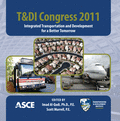Comparison of Predicted Distresses between Different Input Levels Using M-E PDG for CRC Pavement
Publication: Transportation and Development Institute Congress 2011: Integrated Transportation and Development for a Better Tomorrow
Abstract
The Mechanistic Empirical Pavement Design Guide (M-E PDG) provides a number of new approaches for characterizing materials to be used in 21st Century pavement design. The M-E PDG software uses numerical models to analyze traffic, climate, subgrade and laboratory measurements of material properties to predict the performance of various pavement designs over their entire service life. A key element of the mechanistic design approach is the prediction of the response of the pavement materials, and thus of the pavement itself. The M-E PDG provides three hierarchical input levels: Level 1 is site/project specific with actual tests resulting in higher accuracy, Level 2 from less than optimal testing or by correlations and Level 3 from the agency database or user selected default values. Since obtaining Level 1 material inputs require considerable testing effort and cost, Level 1 data for M-E PDG analysis may not be possible all the times. In such situations, Level 2 or 3 inputs can still be used to perform M-E PDG analysis and predict design life of pavement. The objective of this study is to compare M-E PDG predicted distresses of different input level data from a recently constructed Continuously Reinforced Concrete Pavement (CRCP) project at I-64 Battlefield blvd, Chesapeake, Virginia. The original design of this pavement was done using the 93 AAHSTO design method several years before the construction. This paper also documents the efforts associated with the laboratory and field procedures used for level 1 input characterization. The FHWA Mobile Concrete Laboratory (MCL) had performed all the concrete materials characterization for level 1 input on this project. M-E PDG software (version 1.1) is used to obtain the predicted distresses for the pavement structure using the same thickness obtained by AASHTO method. This paper also discusses the difference in predicted distresses when level 1 and level 3 traffic data was used. Results shows that there were significant differences in predicted distresses between Level 1 and Level 3 concrete properties inputs for M-E PDG analysis depending upon the type of Level 3 input used.
Get full access to this article
View all available purchase options and get full access to this chapter.
Information & Authors
Information
Published In
Copyright
© 2011 American Society of Civil Engineers.
History
Published online: Apr 26, 2012
ASCE Technical Topics:
- Comparative studies
- Concrete
- Concrete pavements
- Construction materials
- Design (by type)
- Engineering fundamentals
- Engineering materials (by type)
- Gravels
- Highway and road design
- Infrastructure
- Material mechanics
- Material properties
- Materials characterization
- Materials engineering
- Methodology (by type)
- Pavement condition
- Pavement design
- Pavements
- Research methods (by type)
- Sight distances
- Transportation engineering
Authors
Metrics & Citations
Metrics
Citations
Download citation
If you have the appropriate software installed, you can download article citation data to the citation manager of your choice. Simply select your manager software from the list below and click Download.
